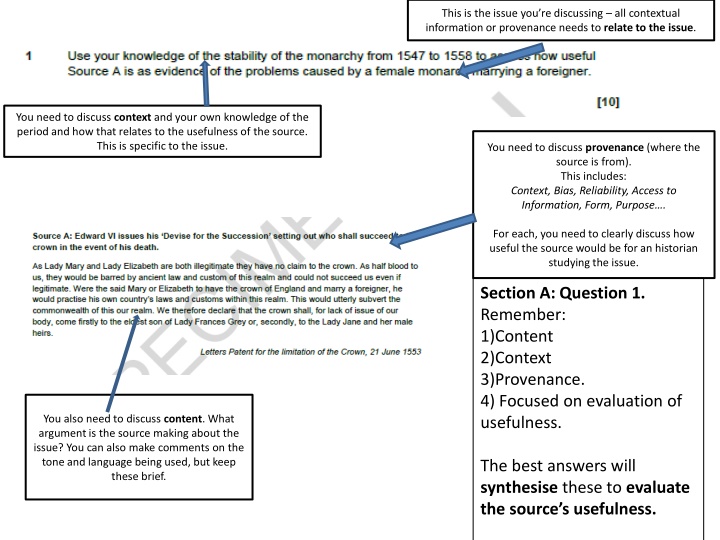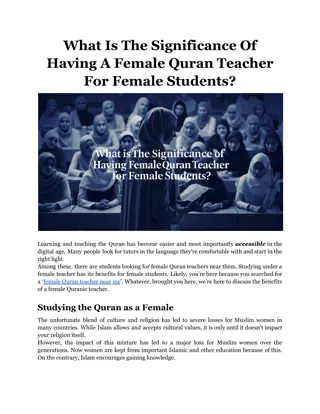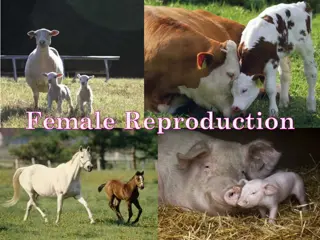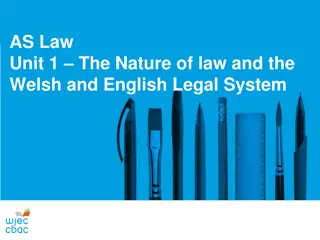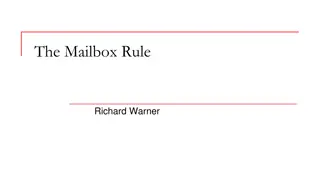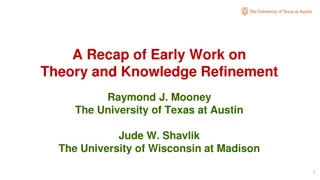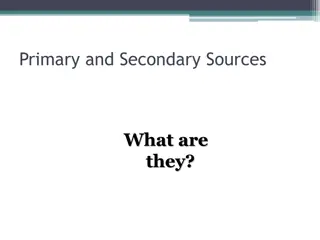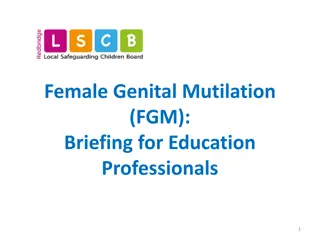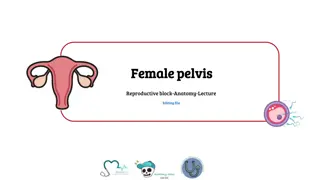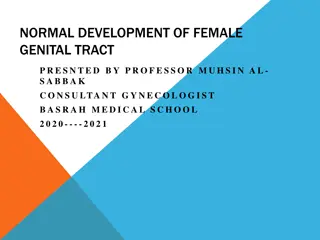Evaluating Sources on Female Rule in the 1550s
This analysis focuses on assessing the reliability and usefulness of historical sources discussing the issue of female rule in the 1550s. It evaluates the content, provenance, and context of the sources to determine their relevance for historians studying the topic. The sources provide insights into the perceptions of female rule, religious beliefs, and political challenges during that period.
Download Presentation

Please find below an Image/Link to download the presentation.
The content on the website is provided AS IS for your information and personal use only. It may not be sold, licensed, or shared on other websites without obtaining consent from the author.If you encounter any issues during the download, it is possible that the publisher has removed the file from their server.
You are allowed to download the files provided on this website for personal or commercial use, subject to the condition that they are used lawfully. All files are the property of their respective owners.
The content on the website is provided AS IS for your information and personal use only. It may not be sold, licensed, or shared on other websites without obtaining consent from the author.
E N D
Presentation Transcript
This is the issue youre discussing all contextual information or provenance needs to relate to the issue. You need to discuss context and your own knowledge of the period and how that relates to the usefulness of the source. This is specific to the issue. You need to discuss provenance (where the source is from). This includes: Context, Bias, Reliability, Access to Information, Form, Purpose . For each, you need to clearly discuss how useful the source would be for an historian studying the issue. Section A: Question 1. Remember: 1)Content 2)Context 3)Provenance. 4) Focused on evaluation of usefulness. You also need to discuss content. What argument is the source making about the issue? You can also make comments on the tone and language being used, but keep these brief. The best answers will synthesise these to evaluate the source s usefulness.
This time you are using all of the sources. You must include Example: Source A is more concerned with illegitimacy or incorrect religious belief as an obstacle to rule than being female, because it passes the succession to women. However, as a clear preference is expressed for a woman with male heirs, showing that there was a legal preference for a male heir all things being equal. Additionally, the major concern was with the possibility of a foreign marriage leading to England s relegation to a junior partner, a question of sovereignty not gender, so female rule was not necessarily a serious problem. Content. Does the text support or oppose the view? This source was produced by King Edward whose was considerably more devout in his Protestantism than his father, so the main concern will be religious belief. Despite this, he has an interest in opposing his older siblings right to the throne as many English people and foreign powers saw Mary as the rightful heir to England. To this end, he is less concerned with opposing female rule than he is with opposing the specific rule of Mary. Specific religious and political rivals are the serious problem for Edward, not female rulers. Provenance. Does the source s origin affect their view? DespiteEdward s acceptance of female rulers, Lady Jane Grey was undeniably a weak monarch of little consequence. Additionally, as Edward predicts, Mary s accession to the throne would lead to considerable debt for England and war with France which would result in the loss of Calais, damaging English interests in preference of the Spanish, indicating that a female ruler could be a serious weakness for a country in the sixteenth century. Context. What close historical event may undermine or support the argument of the source? Despite the promises made by Phillip in Source B, it is apparent that female rule, and marriage to a foreign ruler, would lead to serious problems. Wyatt s Rebellion greatly threatened Mary in her early years, and her marriage to Phillip did lead to serious issues. Edward s predictions of an England whose customs and laws were overthrown did not come true, but English foreign policy was attached to Catholic Habsburg ambitions to the detriment and anger of her people. An overall judgement. Overall, was female rule a serious problem in the 1550s?
Using these three sources in their historical context, asses how far they support the view that Mary s return to Catholic practice was popular. (20) You must include Example: Content. Does the text support or oppose the view? Provenance. Does the source s origin affect their view? Context. What close historical event may undermine or support the argument of the source? An overall judgement. Overall, was female rule a serious problem in the 1550s?
Using these three sources in their historical context, assess how far they support the view that Edward lead a religious revolution? (20) You must include Example: Content. Does the text support or oppose the view? Provenance. Does the source s origin affect their view? Context. What close historical event may undermine or support the argument of the source? An overall judgement. Overall, was female rule a serious problem in the 1550s?
Using these three sources in their historical context, assess how far they support the view that the unrest 1547-58 was primarily caused by religion? (20) You must include Example: Content. Does the text support or oppose the view? Provenance. Does the source s origin affect their view? Context. What close historical event may undermine or support the argument of the source? An overall judgement. Overall, was female rule a serious problem in the 1550s?
You must explain all the sources in answer to this question. This is the issue you re discussing all contextual information or provenance needs to relate to the issue.
You must include Example: Source A is more concerned with illegitimacy or incorrect religious belief as an obstacle to rule than being female, because it passes the succession to women. However, as a clear preference is expressed for a woman with male heirs, showing that there was a legal preference for a male heir all things being equal. Additionally, the major concern was with the possibility of a foreign marriage leading to England s relegation to a junior partner, a question of sovereignty not gender, so female rule was not necessarily a serious problem. Content. Does the text support or oppose the view? This source was produced by King Edward whose was considerably more devout in his Protestantism than his father, so the main concern will be religious belief. Despite this, he has an interest in opposing his older siblings right to the throne as many English people and foreign powers saw Mary as the rightful heir to England. To this end, he is less concerned with opposing female rule than he is with opposing the specific rule of Mary. Specific religious and political rivals are the serious problem for Edward, not female rulers. Provenance. Does the source s origin affect their view? DespiteEdward s acceptance of female rulers, Lady Jane Grey was undeniably a weak monarch of little consequence. Additionally, as Edward predicts, Mary s accession to the throne would lead to considerable debt for England and war with France which would result in the loss of Calais, damaging English interests in preference of the Spanish, indicating that a female ruler could be a serious weakness for a country in the sixteenth century. Context. What close historical event may undermine or support the argument of the source? Despite the promises made by Phillip in Source B, it is apparent the sources support the idea that female rule, and marriage to a foreign ruler, would lead to serious problems. Wyatt s Rebellion greatly threatened Mary in her early years, and her marriage to Phillip did lead to serious issues. Edward s predictions of an England whose customs and laws were overthrown did not come true, but English foreign policy was attached to Catholic Habsburg ambitions to the detriment and anger of her people. An overall judgement. Overall, was female rule a serious problem in the 1550s?
For each source: - Have you discussed content, context and provenance? For your essay: Synthesis: Have you discussed how the context, content and provenance relate? Provenance: Where is it from, and who wrote it? Includes: Context, Bias, Reliability, Access to Information, Form, Purpose . Evaluation: Have you evaluated each source s usefulness and place in your argument? Content: How far does the content support the view? Can you comment on language or tone? Focus: Have you remained focus on the question for each paragraph? Have you routinely linked back to the question? Context: How does the context change, undermine or support the argument of the source? Is your information accurate, justified and detailed? Supported Analysis: Have you justified your assertions with evidence from the sources or context?
